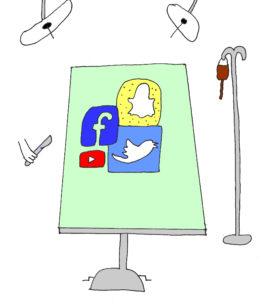by Craig Klugman, Ph.D.
The Internet and social media have raised hosts of new ethical issues in the health care world: Should doctors friend their patients? Should med students post photos of their cool cases? Should doctor diagnose people online? The general answer for these questions has been no: “Friending” a patient is a boundary crossing, posting patient photos is a confidentiality violation and diagnosing a patient online (not through a formal telemedicine process) violates standards of care. But some online technologies have been adopted in full such as emailing your doctor and interacting with your health care provider through an online portal. The latest question in cyberspace is whether social media can be used for teaching purposes such as livestreaming an unusual surgery or tweeting (or snapchatting) a procedure? A new article in the journal Plastic and Reconstructive Surgery provides guidelines as to when social media teaching can occur.

Consider Grey’s Anatomy (Season 8, Episode 3) where Bailey live tweets her surgery and in Season 10, episode 11, where Christina livestreams a groundbreaking surgery and then turns off the cameras when the surgery starts going wrong. In both episodes, the use of social media turns out poorly. In the real world, surgeons have placed videos on YouTube to educate and sell their services (see this outdated list from 2010) while others broadcast live surgeries while in costume or dancing.
In “Ethics of Sharing Plastic Surgery Videos on Social Media,” the authors found 37 articles that discussed social media and plastic surgery. They used principlism to find serious concerns with live broadcasting of these surgeries and created a set of guidelines for using social media in this way:
- Get informed consent. The authors suggest covering all identifying marks to preserve confidentiality and to make sure that consent disclosure includes information on where the video will be shared.
- Reaffirm patient right to refuse recording and live streaming. The authors say to avoid coercion and let the patient know that they can request the video be deleted at any time.
- However, once posted, videos can be shared and copied and broadcast anywhere. Thus, deleting the surgeon’s posting will likely not remove the video from all social media.
- Uphold the American Society of Plastics Surgeons Code of Ethics.
- Use a professional videographer to avoid increasing surgical time. The surgeon is responsible for overseeing the social media use herself and for her staff.
The American Society of Plastics Surgeons Code of Ethics mostly deals with issues of business—representation, advertising and charging for services. The first two principles of the code are relevant here: 1. “…render services to humanity with full respect for human dignity” and 2. “…affirmative duty to disclose new medical advances to patients and colleagues.” The question social media teaching raises is whether the second principle—discloses new advances—interferes with the first—practicing full respect for human dignity. By saying that a signed informed consent should be part of the process, the authors are placing an emphasis on autonomy and essentially saying that as long as the patient understands and consents, that broadcasting is fine. From a slightly more paternalistic stance, can a patient grasp that anything on the internet lives forever and even if the surgeon deletes, that the video does not go away? Does the surgeon owe the patient more nonmaleficence than can be covered under consent? Is informed consent enough because the permission is not for the surgery but for the broadcast? Who stands to gain from these events: Is it really just about the training others or is this an attempt to attract patients or trainees or to become a YouTube star? Is there a potential for financial gain or even prestige for the surgeon that could be a conflict of interest?
Additionally, there are issues of whether this is an effective method of teaching. Have learners been assessed to see if they learn new skills, techniques and improve their own patient outcomes as a result of viewing? Or is this mostly voyeurs?
These guidelines are an interesting start to a conversation but are not the solution. After all, the authors admit the guidelines come out of principlism, which is one mid-level ethical theory out of several and has its own critics. Even within a principlist analysis, the emphasis here appears to be on autonomy with less attention to nonmaleficence and beneficence. I would add some guidelines to this list:
- The livestreaming must not benefit the surgeon financially in anyway as this could create the appearance of a conflict of interest
- The most restrictive privacy options available on the social media site should be adopted (Thus not everyone may be able to see it, but they could view it if they request access from the surgeon and demonstrate they have a legitimate use for the viewing such as education).
- Informed consent is for medical procedures, a consent for taping and streaming needs to be a separate agreement and should discuss, among other things, who maintains copyright of the video and whether any revenue generated (saying advertising on the surgeon’s YouTube channel) is to be shared.
- A clear statement of how the patient may or may not benefit from being featured in the social media.
- An understanding that being part of the social media event can affect one’s family members. For example, if the surgery is to correct a genetic concern, then one has outed other family members who may have inherited the same gene and may not want that publicly known.
Social media has become an entrenched part of our world and continues to offer challenges to the health care professions, which are entrusted with keeping people’s deepest secrets. The authors of this article begin a needed conversation but what they offer is just a beginning.